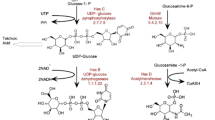Summary
A number ofAspergillus nidulans mutants unable to grow on lactose or growing very poorly on this sugar have been isolated. They may be divided into two major groups: to the first belong mutants in which β-galactosidase can be induced by galactose but not by lactose. Mutants of the second group are induced neither by lactose nor by galactose. Mutants of the first group showed an impaired lactose-permease system, while those of the second group most likely concern β-galactosidase structural or regulatory genes as they show a normal rate of lactose uptake. Genetic analysis revealed that mutants from the first group fall into three different loci and those from the second into four loci. No mutant has been found so far with the lactose-permease system and β-galactosidase simultaneously impaired, or with a constitutive level of either activity.
The wild-type strain ofAspergillus nidulans grows on lactose as the sole carbon source. The two enzymes necessary for the utilization of lactose, that is lactose permease (which is likely to be a complex system) and β-galactosidase show an inductive response to lactose and galactose (Paszewskiet al., 1970). Mycelia grown on glucose show a low level of permease activity which rises 7–10-fold upon induction by lactose, and no activity of β-galactosidase. Induction of both enzymes is not time-coordinated — the induction of permease preceeds the induction of β-galactosidase. In contrast toNeurospora crassa (Bates and Woodward, 1964; Bateset al., 1967; Lester and Byers, 1965) only one type of β-galactosidase with pH optimum 7.5–7.6 was found inAspergillus nidulans.
A number of mutants unable to grow on lactose or growing very poorly on this sugar have been isolated. Their genetic and enzymatic characterization is given in this paper.
Similar content being viewed by others
References
Bates, W. K., Hedman, S. C., Woodward, D. O.: Comparative inductive responses of two B-galactosidases ofNeurospora. J. Bact.93, 1631–1637 (1967).
Bates, W. K., Woodward, D. O.:Neurospora beta-galactosidase: Evidence for a second enzyme. Science146, 777–778 (1964).
Gajewski, W., Litwińska, J.: Lactose negative mutants ofAspergillus nidulans. Aspergillus News 3 Letter No 10, 17–18 (1969).
Lester, G., Byers, A.: Properties of two beta-galactosidases ofNeurospora crassa. Biochem. biophys. Res. Commum.18, 725–734 (1965).
Paszewski, A., Chojnacki, T., Litwińska, J., Gajewski, W.: Regulation of lactose utilization inAspergillus nidulans. Acta biochim. polon.17, 385–391 (1970).
Pontecorvo, G., Käfer, E.: Genetic analysis based on mitotic recombination. Advanc. Genet.9, 71–100 (1958).
Pontecorvo, G., Roper, J. A., Hemmonds, L. M., MacDonald, K. D., Bufton, A. W.: The genetics ofAspergillus nidulans. Advanc. Genet.5, 141–238 (1953).
Roberts, C. F.: The genetic analysis of carbohydrate utilization inAspergillus nidulans. J. gen. Microbiol.31, 45–58 (1963).
Author information
Authors and Affiliations
Additional information
Communicated by F. Kaudewitz
Rights and permissions
About this article
Cite this article
Gajewski, W., Litwińska, J., Paszewski, A. et al. Isolation and characterization of lactose non-utilizing mutants inAspergillus nidulans . Molec. gen. Genet. 116, 99–106 (1972). https://doi.org/10.1007/BF00582220
Received:
Issue Date:
DOI: https://doi.org/10.1007/BF00582220




